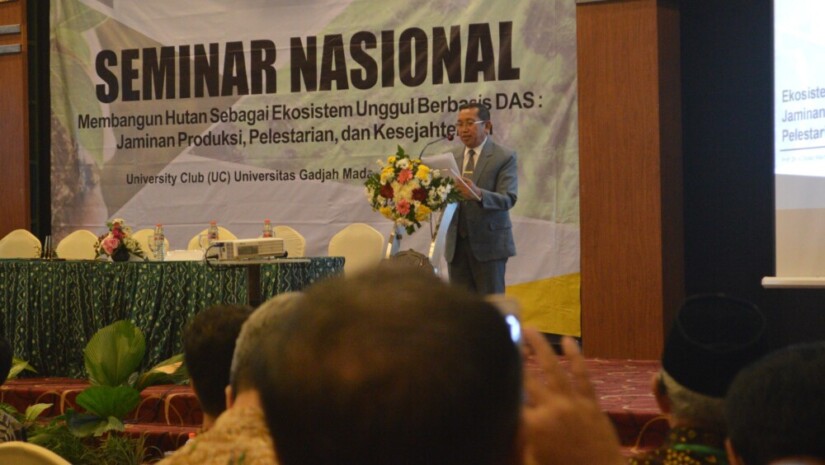
Cross-sector synergy is a sine qua non prerequisite in functioning forests as disaster risk reduction. Watershed as a landscape unit is an arena for the dynamics of programs and activities of various sectors.
However, many programs and activities have contradictory visions and goals but are implemented in activities that negate each other. The most factual example is the contradiction between the forestry sector’s catchment restoration project and the agricultural sector’s effort to increase food production through extensification (legal and illegal).
“Corn commercialization in Gorontalo, for instance, sparked a trend in corn cultivation that escalated to areas with unsuitable topographic conditions for seasonal crops. This results in massive erosion and sedimentation,” said Dr. Ir. Ida Bagus Putera Parthama, M.Sc, Director General of Watershed Management and Protected Forests, Ministry of Environment and Forestry, in the National Seminar of Developing Forests as Watershed-Based Superior Ecosystem: Guarantee of Production, Conservation, and Welfare, at University Club UGM, Thursday (8/23).
Another example is the challenging forest rehabilitation near Citarum River, where rehabilitation plants are considered as a nuisance by vegetable farmers who controlled the protected forests.
For this kind of situations, said Ida Bagus, a compromise between sectors is a precondition for successfully placing forests as disaster risk reduction. Coordination with Public Works and Public Housing Ministry is essential, especially in resource effectiveness (funds).
Strengthening the role of forest ecosystems must be linked to its strategic role in regional development to reap the benefits and gain support for these efforts. The watershed-based landscape approach not only places the role of forest ecosystems as disaster risk reduction but also as a socio-economic setting and regional development.
“The calculation of Bone Balango Watershed Management Agency in Bogani Nani Wartabone National Park in 2016 showed that forests are capable of storing more water than Gajah Mungkur reservoir in Wonogiri. These data legitimize forest rehabilitation as an important program of water resources infrastructure.”
The national seminar is held for the retirement of Prof. Dr. Ir. Djoko Marsono. This collaboration between UGM Faculty of Forestry and Directorate General of Watershed and Protected Forest Management presented several speakers, including Dr. Ir. Hilman Nugroho, M.P., Director General for Sustainable Management of Production Forests, Ir. Wiratno, M.Sc., Director General for Nature Conservation and Ecosystems, and Ir. Nazir Foead, M.Sc., Head of Peat Restoration Agency.
Faculty of Forestry’s Dean, Dr. Budiadi, S.Hut., M.Agr.Sc., stated superior ecosystem is an idea of Prof. Djoko Marsono in forest ecology. The idea plays an important role in the conservation of natural resources in Indonesia.
“The superior ecosystem thinking is a critique of many forest management practices that simplify the complexity in forest ecosystems.”
According to Budiadi, superior ecosystems do not only recognize complexity, but the management must be based on the understanding that ecosystems in each region are unique, including those based on watersheds. Therefore, this seminar is expected to make adjustments to the implementation framework and the formation of criteria and indicators for forests as superior ecosystems with various complexities.
Meanwhile, Prof. Dr. Ir. Djoko Marsono in his retirement speech stated in a superior ecosystem, ecosystems (forest) can be built with species (commodities) that are based on their physical conditions and the community can get maximum benefit while still maintaining forest conservation. An ecosystem in principle is not only a forest structure that follows the rule of ecosystems, but the ecological processes within can function once again.
Unfortunately, the interest in studying the role of animals and other components in ecosystems is still very low, which results in ecological imbalances.
“It is time for us to realize that there are no stand-alone components in each ecosystem. There are still opportunities to improve them. Likewise, the mindset that forest products are tangible benefits must be immediately changed through an accurate economic valuation,” he added.

